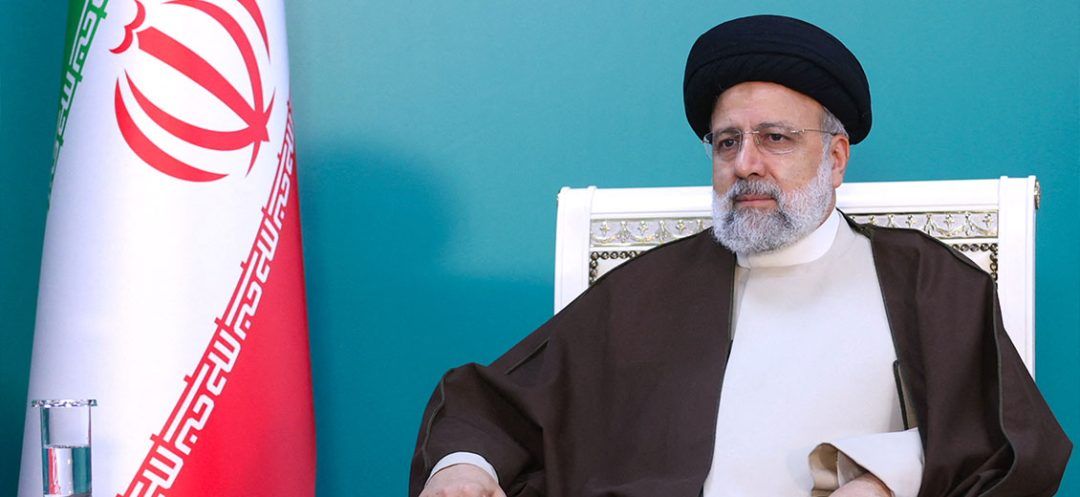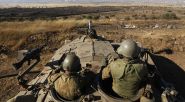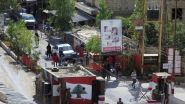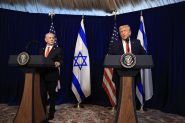
©Iranian Presidency / AFP
“The butterfly effect” refers to a phenomenon where an event occurring in one place can trigger significant consequences in a distant area. The Lebanese people have experienced this effect for decades. Now, they face it once again with the deaths of Iranian President Ebrahim Raisi and his Minister of Foreign Affairs, Hussein Amir-Abdullahian, on Sunday, following a helicopter crash near the border with Azerbaijan.
Was it an accident or an assassination tied to a broader conspiracy?
Speculations were rife on Sunday, stretching well into the night, regarding the circumstances of the tragedy. Beyond the official explanation citing adverse weather conditions as the cause, it is likely to take a significant amount of time to fully elucidate the true reasons behind the deaths of the Iranian president, the Minister of Foreign Affairs, the Head of Diplomacy, along with other high-ranking officials.
For the Lebanese people, the traditional question Sunday evening on every lip revolved around the potential repercussions of this development on Lebanon. As our fate is inadvertently intertwined, through Hezbollah, with that of the Islamic Republic of Iran, understanding the shockwave that might hit Lebanon requires scrutinizing the possible consequences within Iran itself first.
In the immediate term, the presidency itself is not expected to face the most significant repercussions. The transitional phase is likely to unfold smoothly, with a new president anticipated to be elected within the next fifty days.
The presidency does not hold the utmost significance within the political structure and hierarchy of the Islamic Republic. Major strategic decisions rest solely with the Supreme Leader (the wali al-faqih). However, President Raisi, recognized for his radical attitude in wielding power, was uniquely poised to succeed the current Supreme Leader, Ali Khamenei, who is both advanced in age and grappling with serious health issues. Therefore, Raisi's disappearance will mainly be felt in the context of Khamenei's succession, especially since maneuvers towards this succession have already recently begun.
Another significant repercussion, and perhaps the most crucial, warrants close scrutiny on an equally strategic level. The death of the Iranian president amidst a shifting regional and international landscape, compounded by widespread popular dissent challenging the very foundations of the Islamic Republic, could pave the way for a fervent resurgence of internal power struggles. This, in turn, would likely prompt a redefinition of the balance of power (and roles’ distribution) between the Pasdaran (the radical wing of Iranian power) and the often described “moderate” or “reformist” faction, which, though inaccurately, is perceived to represent “the State.”
The cleavage between these two camps is confirmed by former Iranian Minister of Foreign Affairs Mohammad Javad Zarif, who, in his memoirs, highlights a discord that surfaced in certain circumstances (particularly in Afghanistan) between the Pasdaran’s action (which he describes as the “military-security” wing of power) and the action of what he terms “diplomacy.” During the tough negotiations on the nuclear dossier, Zarif publicly accused this “military-security” wing of obstructing his talks with the US. Additionally, the presence of a “moderate and reformist” faction was further confirmed by an active Iranian minister who openly criticized the excessive brutality of the repression during the 2022 popular uprising, which was sparked by the death of Mahsa Amini while in custody.
Raisi’s disappearance could thus serve as a catalyst for redefining the balance of power and the distribution of roles between these two camps, potentially reshaping the influence and strategy of the Pasdaran. This ripple effect will be acutely felt in Lebanon, where Hezbollah acts as the primary armed wing and spearhead of the Pasdaran in the Lebanese arena and the broader Middle East. Such an impact could weigh particularly heavily amid the ongoing war of attrition in southern Lebanon.
The potential confusion in the evolution of Iran’s struggles for influence is bound to affect Hezbollah's posture. With developments unfolding in Tehran, will the Shiite party opt to moderate its action on the regional level, especially along the Israeli border, until the fate of its Iranian godfather becomes clear? Alternatively, could it be compelled to escalate by the Revolutionary Guards, who may exploit this scenario to safeguard their expansionist strategy in the region?
On a strictly Lebanese level, Hezbollah might be brought to harden its positions in the short term in order to compensate for the potential weakening of its Iranian tutor. However, over the medium to long term, a possible loss of Pasdaran’s influence could only lead to a gradual decline in Hezbollah's various means of action, leading to “demilitarizing” the Shiite party and significant repercussions on the internal balance of power.
A preliminary outline for navigating the crisis in Lebanon inevitably involves a redistribution of power in Iran, likely necessitating the permanent trimming of the Pasdaran’s wings. This is crucial for safeguarding Lebanon's specificities and, undoubtedly, promoting stability in various parts of the Western world, drawing from the well-known “butterfly effect” phenomenon.
Was it an accident or an assassination tied to a broader conspiracy?
Speculations were rife on Sunday, stretching well into the night, regarding the circumstances of the tragedy. Beyond the official explanation citing adverse weather conditions as the cause, it is likely to take a significant amount of time to fully elucidate the true reasons behind the deaths of the Iranian president, the Minister of Foreign Affairs, the Head of Diplomacy, along with other high-ranking officials.
For the Lebanese people, the traditional question Sunday evening on every lip revolved around the potential repercussions of this development on Lebanon. As our fate is inadvertently intertwined, through Hezbollah, with that of the Islamic Republic of Iran, understanding the shockwave that might hit Lebanon requires scrutinizing the possible consequences within Iran itself first.
In the immediate term, the presidency itself is not expected to face the most significant repercussions. The transitional phase is likely to unfold smoothly, with a new president anticipated to be elected within the next fifty days.
The presidency does not hold the utmost significance within the political structure and hierarchy of the Islamic Republic. Major strategic decisions rest solely with the Supreme Leader (the wali al-faqih). However, President Raisi, recognized for his radical attitude in wielding power, was uniquely poised to succeed the current Supreme Leader, Ali Khamenei, who is both advanced in age and grappling with serious health issues. Therefore, Raisi's disappearance will mainly be felt in the context of Khamenei's succession, especially since maneuvers towards this succession have already recently begun.
Another significant repercussion, and perhaps the most crucial, warrants close scrutiny on an equally strategic level. The death of the Iranian president amidst a shifting regional and international landscape, compounded by widespread popular dissent challenging the very foundations of the Islamic Republic, could pave the way for a fervent resurgence of internal power struggles. This, in turn, would likely prompt a redefinition of the balance of power (and roles’ distribution) between the Pasdaran (the radical wing of Iranian power) and the often described “moderate” or “reformist” faction, which, though inaccurately, is perceived to represent “the State.”
The cleavage between these two camps is confirmed by former Iranian Minister of Foreign Affairs Mohammad Javad Zarif, who, in his memoirs, highlights a discord that surfaced in certain circumstances (particularly in Afghanistan) between the Pasdaran’s action (which he describes as the “military-security” wing of power) and the action of what he terms “diplomacy.” During the tough negotiations on the nuclear dossier, Zarif publicly accused this “military-security” wing of obstructing his talks with the US. Additionally, the presence of a “moderate and reformist” faction was further confirmed by an active Iranian minister who openly criticized the excessive brutality of the repression during the 2022 popular uprising, which was sparked by the death of Mahsa Amini while in custody.
Raisi’s disappearance could thus serve as a catalyst for redefining the balance of power and the distribution of roles between these two camps, potentially reshaping the influence and strategy of the Pasdaran. This ripple effect will be acutely felt in Lebanon, where Hezbollah acts as the primary armed wing and spearhead of the Pasdaran in the Lebanese arena and the broader Middle East. Such an impact could weigh particularly heavily amid the ongoing war of attrition in southern Lebanon.
The potential confusion in the evolution of Iran’s struggles for influence is bound to affect Hezbollah's posture. With developments unfolding in Tehran, will the Shiite party opt to moderate its action on the regional level, especially along the Israeli border, until the fate of its Iranian godfather becomes clear? Alternatively, could it be compelled to escalate by the Revolutionary Guards, who may exploit this scenario to safeguard their expansionist strategy in the region?
On a strictly Lebanese level, Hezbollah might be brought to harden its positions in the short term in order to compensate for the potential weakening of its Iranian tutor. However, over the medium to long term, a possible loss of Pasdaran’s influence could only lead to a gradual decline in Hezbollah's various means of action, leading to “demilitarizing” the Shiite party and significant repercussions on the internal balance of power.
A preliminary outline for navigating the crisis in Lebanon inevitably involves a redistribution of power in Iran, likely necessitating the permanent trimming of the Pasdaran’s wings. This is crucial for safeguarding Lebanon's specificities and, undoubtedly, promoting stability in various parts of the Western world, drawing from the well-known “butterfly effect” phenomenon.
Read more




Comments